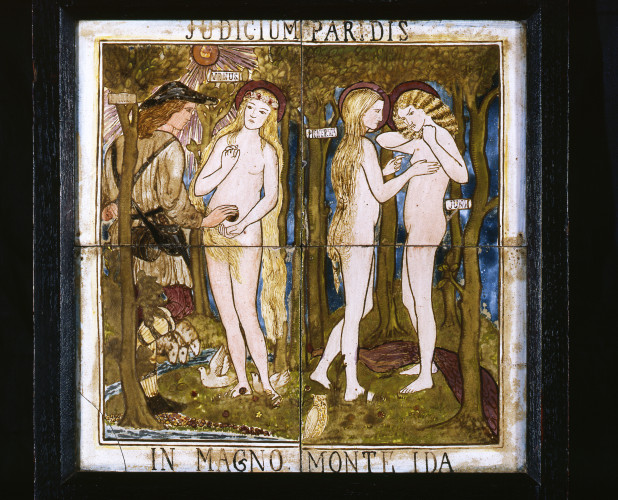Early in 1862, Edward Burne-Jones recorded in his account book (Fitzwilliam Museum, Cambridge) a series of designs for painted tiles with subjects from Greek mythology. The Judgement of Paris depicts the episode from the Greek legend when Paris, Prince of Troy has to chose the most beautiful of the three godessess and presents an apple to Venus, thus setting in train the Trojan War. The Latin inscription translates as ‘The Judgment of Paris on great Mount Ida’.
Painted in the Red Lion Square workshops of Morris, Marshall, Faulkner & Co.- of which Burne-Jones was a founder-partner with Wiliam Morris, Dante Gabriel Rossetti, Ford Madox Brown et al.- the tiles are an early and delightful example of the Pre-Raphaelite taste for depicting classical scenes in medieval guise. Paris is shown in cross-gartered leggings and huntsman’s cap, while the three godesses are distinctly late-Gothic in their bodily proportions. Identified by their named scrolls, the four figures stand in an enclosed, stylish landscape in the manner of a medieval tapestry or manuscript illumination.
Handpainted tiles were an important product of the Morris firm from its establishment in 1861 until the mid-1870s. Some were used as overmantels but others, as in this case, were intended to be framed and diplayed as pictures in their own right.
The only other known version of the tile panel is at Kelmscott Manor and differs in several details, notably that the scene is painted on 5-inch square tiles bordered with 12 blue tiles painted with an inscription by William Morris in black. It has been suggested that the Kelmscott Manor panel was to be shown at the International Exhibition at South Kensington later that year but was withdrawn from Morris, Marshall, Faulkner & Co’s exhibit when the ‘decorative value of verses’ was criticized by William Burges, one of the judges. If so, it is possible that this version, omitting Morris’s verses and with an integral simple inscription, was the version shown by the Firm at the Exhibition.

